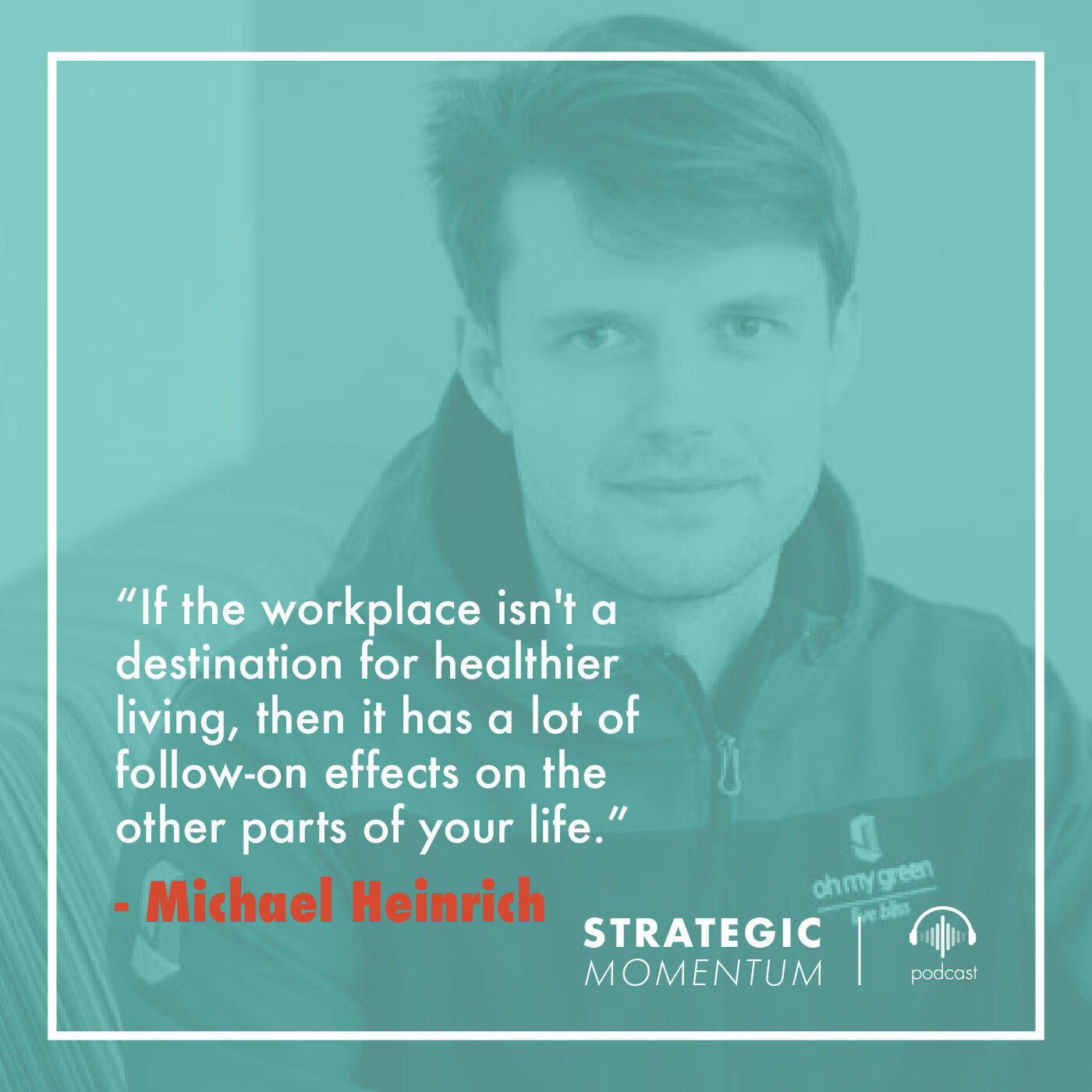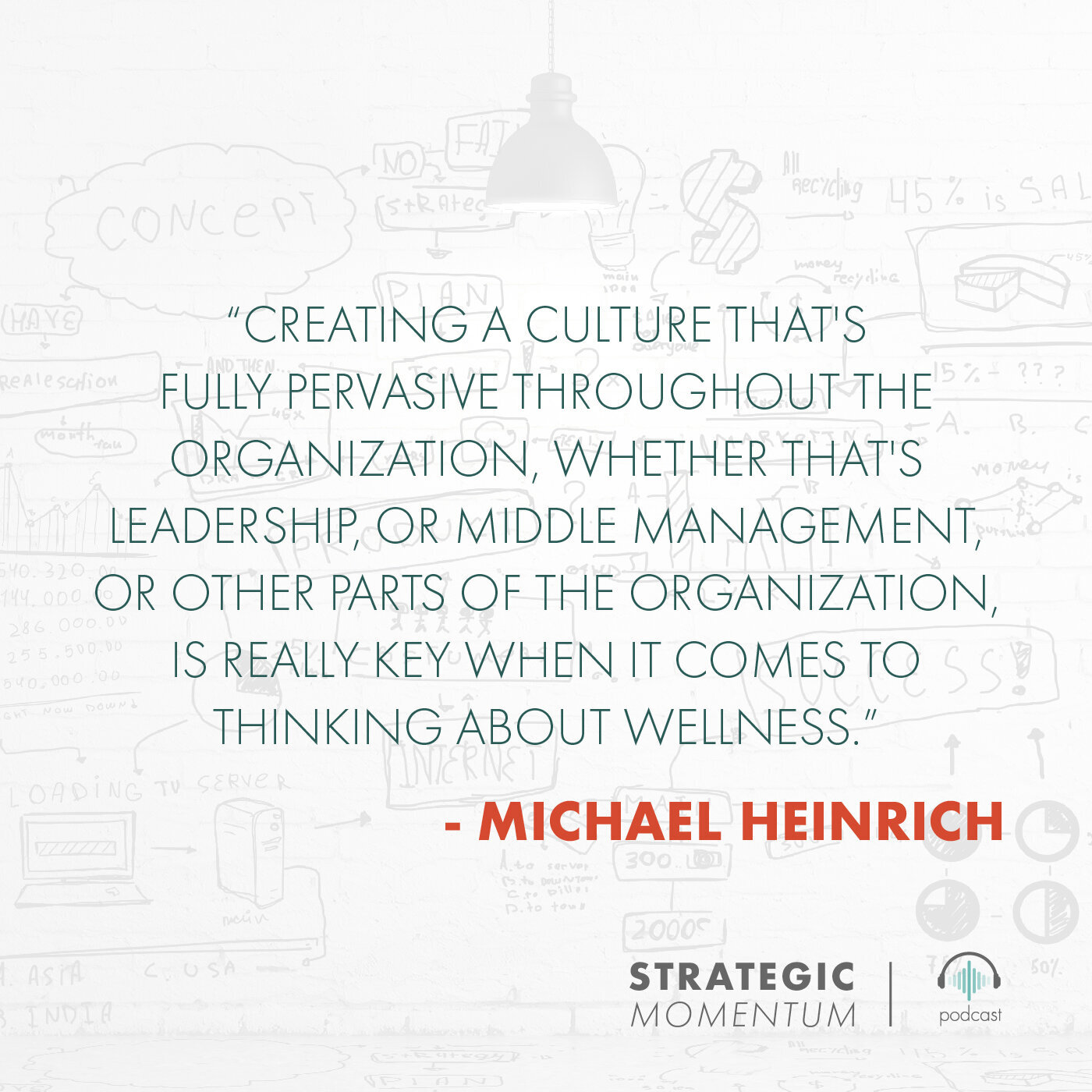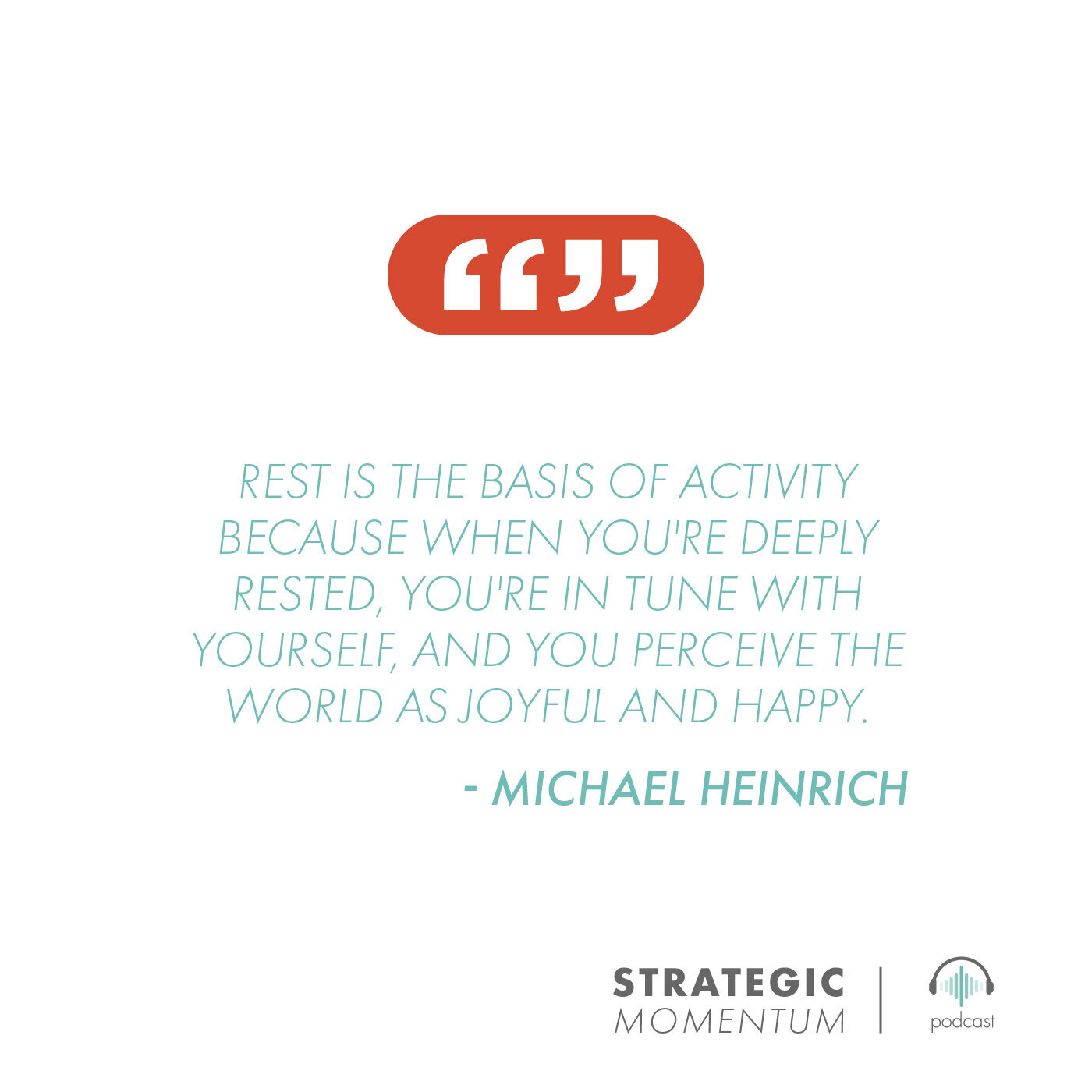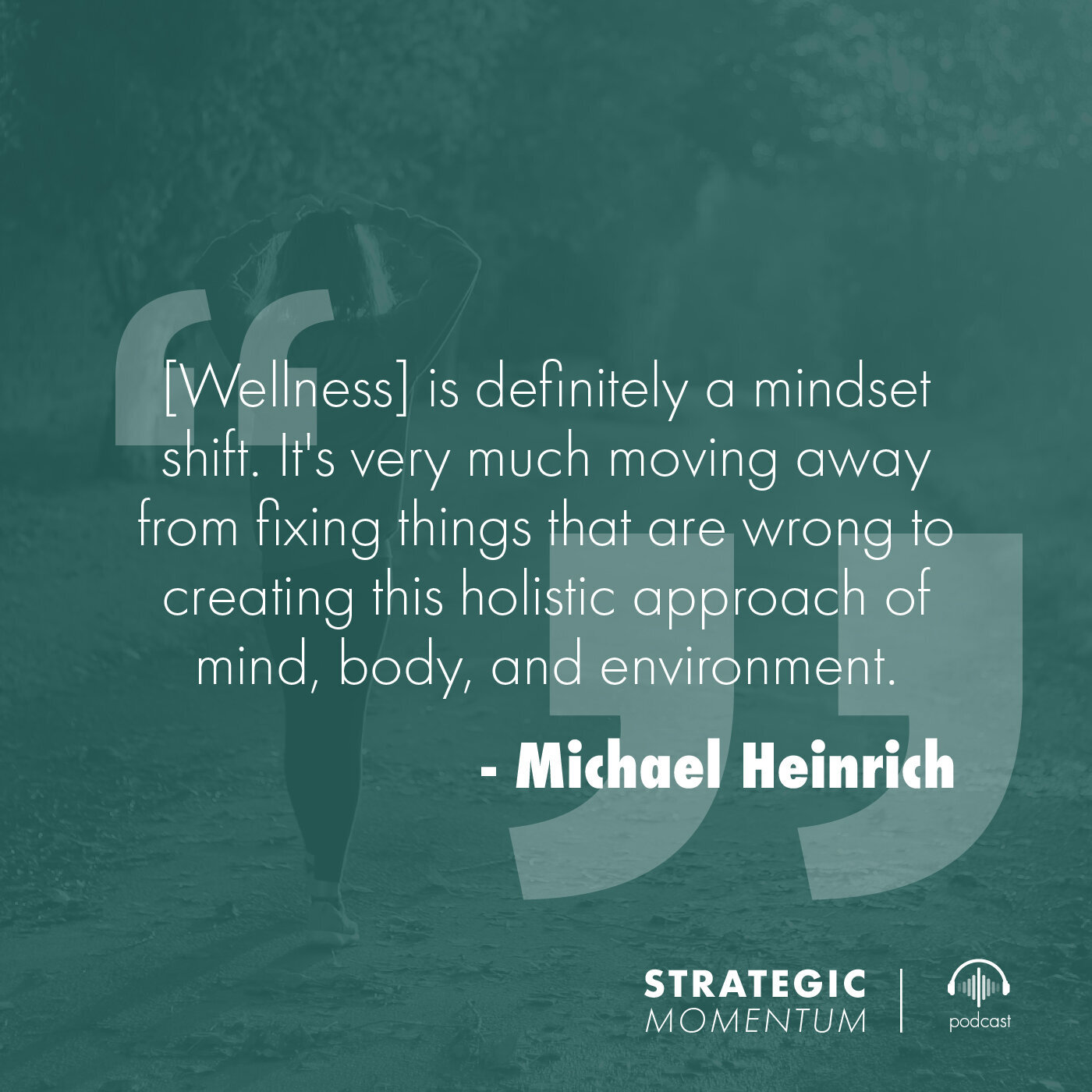Ep. 56 - Building Wellness into the Fabric of Your Corporate Culture to Drive Workforce Momentum - with Michael Heinrich
Find Us Wherever You Listen To Podcasts
Investment in corporate wellness continues to gain momentum as many companies acknowledge the importance of keeping their workforce healthy, happy, and, ultimately, more productive and engaged. Yet the implementation of these programs aren’t necessarily translating into sustainable health outcomes.
Michael Heinrich has made it his mission to help companies create healthier and happier environments for their employees, and for him it begins with nutrition. He is CEO of Oh My Green, a concierge-style provider of healthy food and wellness services for corporations of all sizes. In this episode, Michael shares what it takes to truly deliver on workplace wellness.
You learn:
The experiences and drivers that led Michael to starting Oh My Green.
What wellness really is and what inhibits a company’s ability to establish an environment that optimizes employee well-being, productivity, and engagement.
What it takes to implement a sustainable culture of wellness throughout an organization.
A Journey of Discovery and Exploration, Starting in Grandma’s Garden
Michael’s journey into wellness began when he was a child, though the manifestation of that early health education didn’t appear until much later. At 5 or 6 years old, he was influenced by is grandmother, a medical doctor in Berlin, who preached the importance of healthy eating and preventative practice. She ingrained in him that this all had to be a part of daily life.
Michael was also fascinated by technology and anything internet-related, and he had the opportunity to get exposed to that world through his father’s work experience at SAP. He says, “I think that shaped the way I was thinking about technology, and the importance of it, and implementing it wherever I go.”
That lead to roles very early in his career at Microsoft and SAP. But his desire to gain a more holistic understanding of the way businesses operated, from not only strategic level but also an operational one, led him to working at both management consulting firm Bain & Company and hedge fund Bridgewater Associates. It was actually at Bridgewater where he was able to experience, for the first time, how wellness practices could be integrated into a work environment.
But even with all these experiences, Michael realized that what he was doing wouldn’t have the social impact on the world he wanted to see. It was missing a sense of purpose and, ultimately, fulfillment.
He also noticed he had strayed away from those early roots in healthy eating — and it was affecting his overall performance and wellbeing.
“Sodas and M&Ms were easily available and free. And so, I was gravitating towards those and eating them because they were just available. But then, I was sugar crashing. I wasn't feeling great. I wasn't sleeping enough because I didn't quite have the knowledge of eight hours of sleep doesn't necessarily mean it's good for you when you're going to bed at 3:00 a.m. every day.”
He took control by making another career pivot and embarked on an entrepreneurial journey that would combine his technology and business skills coupled with his familial passion for preventative health — a cause he knew he would never tire of.
The result: Oh My Green.
Delivering Impact, One Healthy Snack at a Time
Today, Oh My Green is a concierge-style provider of healthy food and wellness services for corporations of all sizes. The company brings micro-kitchens, micro-markets, catering, café management, subscription boxes, and more to workplaces to promote nutritious snacks, meals, drinks, and wellness practices in the workplace. And it’s all powered by an AI-driven, user-friendly wellness platform, as well as other IoT devices.
Their motto — “Eat Healthy and Work Happy” — is backed up by their mission to empower companies to provide their people with healthier choices so that they can reach their full potential, both at work and in their daily lives.
Michael and Oh My Green believe wellness starts with nutrition, and as most people spend the majority of their time at work, healthy eating habits adopted in the workplace can permeate into other parts of one’s life.
And they’ve taken the time to understand an employee’s snacking journey in order to create a great experience that makes it as easy as possible to push people along that healthy path.
Understanding That Wellness isn’t One-Dimensional
Wellness isn’t the narrow definition that many have. Rather, it is much more holistic in nature and encompasses the three pillars of mind, body, and environment. And in your body, nutrition is a key component.
Overcoming misconceptions and bad habits not only takes educating companies and their employees on what wellness really means, but also shifting the ‘mindset and culture that working as hard as possible is the right thing to do under any circumstances.’
This work-hard-play-hard attitude, coupled with a mentality of being able to fix anything with modern Western medicine, can’t be the norm. There has to be a shift from a reactionary perspective to a more proactive, preventative one.
Creating that Culture of Wellness
Facilitating a balance of mind, body and environment starts with shifting the institutional mindset and creating a culture of wellness — which, for many companies, must start at the leadership level. And that culture change doesn’t happen overnight.
It requires everyone in the organization to truly live it and feel supported in reaching their wellness goals. That can be achieved by starting with something small and personal, testing and learning individually over time so that in the end employees form healthier habits that last. Creating this culture also involves having a variety of options available. The goal should be to make these practices pervasive in every facet of your business—so everyone shifts from being reactive to being proactive and, ultimately, achieving a healthier, more blissful life.
Michael’s Career Advice
“Rest is the basis of activity because, when you’re deeply rested, you’re in tune with yourself and you perceive the world as joyful and happy.”
Key Takeaways:
While wellness practices have been around for generations, over time the connection between what we think is good for our bodies and what really is has been lost. However, the recent explosion of wellness practices have been driven by:
Millennial perspective - they view health as an active daily pursuit and less of an absence of disease.
Technology - offers the ability to gather more robust information around what one is doing to and with their body in order to make smarter decisions.
Wellness has three main components — mind, body, and environment.
Mind - represents mental as well as emotional health (e.g. rest and a stress-free environment).
Body - composed of nutrition and physical activity.
Environment - entails physical space (e.g. building and good lighting and clear air in it) as well as company culture.
Nutrition is 50% of wellness, and when it comes to the workplace, you consume most of your calories at work. So if that environment isn't a destination for healthier living, then it affects other parts of your life.
A culture of wellness in an organization is critical to delivering on workplace well-being, productivity, and engagement. It’s demonstrating a holistic understanding of what it means to be well and conducting business in a way that’s aligned with these beliefs.
This starts at the top, with leaders setting an example and creating a formal support structure for employees to realize their goals so this isn’t treated as a short-term fix, but rather a lifestyle change.
This needs to be pervasive throughout every facet of the business so that everyone embodies the right mindset and behaviors.
There is no one-time solution to wellness (e.g. only looking at weight loss and providing employees an immediate reward for that near-term goal). That can be perceived by employees as a company’s intention to only serve their financial objectives (reducing health care costs) or even just lip service vs. it being a purposeful, authentic cause to better everyone’s lives.
To achieve this sustainable behavior and mindset of wellness, start with small achievable tasks that are personalized, testing and learning over time to understand what sticks.
The goal is to shift the behavior and mentality from being reactive and siloed to preventative and comprehensive.
Offer a variety of options to employees for how they can fulfill their wellness journey.
For example, offer an hour to do whatever mental or physical activity they choose (walking, meditation, yoga, strength training), or offering a variety of classes as opposed to one or two.
You can also sponsor bigger, team-wide activities, such as mandatory quiet times, company meditation retreats, outdoor meetings, or even filling the office with plants.
Employ a pull vs. push model to get employees to participate in wellness programs and practices; giving them choices helps nudge them in.
Experiment with various wellness practices to see what works for the organization.
Rewards such as points or bonuses for healthy behavior are ultimately not as effective as demonstrating the long-term benefits of wellness—energy, focus, clarity, and overall happiness.
DOWNLOAD THE EBOOK
Get the key insights and advice from this episode in a PDF presentation.













